
Crispino e la comare o Il medico e la morte (The Cobbler and the Fairy or The Doctor and Death) is an opera written collaboratively by Luigi Ricci and Federico Ricci with an Italian libretto by Francesco Maria Piave.

Crispino e la comare o Il medico e la morte (The Cobbler and the Fairy or The Doctor and Death) is an opera written collaboratively by Luigi Ricci and Federico Ricci with an Italian libretto by Francesco Maria Piave.
The premiere took place on 28 February 1850 at the Teatro San Benedetto in Venice.
The work was very popular during the 19th century, and was a favourite of Italian touring companies in the Americas, and in the Asia-Pacific region.
It had its London premiere on 17 November 1857 at St James's Theatre. It was first performed in Paris on 4 April 1865 in Italian by the Théâtre Italien and was performed on 18 September 1869 as Le Docteur Crispin, with a French translation by Charles Nuitter and Alexandre Beaumont, at the Théâtre de l'Athénée on the rue Scribe. [1] Its Calcutta premiere was in 1867 at the Calcutta Opera House, [2] and its Australian premiere was on 11 August 1871 at the Princess Theatre (Melbourne). [3]
Though it was rarely performed in the 20th century, the Festival della Valle d'Itria in Martina Franca, Italy staged the work as part of its 39th opera festival in July 2013. Bass-baritone Domenico Colaianni sang Crispino, while the role of Annetta was taken by Stefania Bonfadelli. [4]
| Role | Voice type | Premiere cast, 28 February 1850 [5] |
|---|---|---|
| Crispino Tachetto, the cobbler | bass | Carlo Cambiaggio |
| Fabrizio, a doctor | baritone | Luigi Rinaldini |
| Mirabolano, a doctor and apothecary | bass | Luigi Ciardi |
| Contino del Fioro, a Tuscan nobleman | tenor | Giuseppe Pasi |
| Don Asdrubale di Caparotta, a Sicilian miser | bass | Angelo Guglielmini |
| Bortolo, a mason | tenor | |
| Annetta, Crispino's wife | soprano | Giovannina Pecorini |
| Lisetta | mezzo-soprano | Paolina Prinetti |
| La Comare, the fairy | mezzo-soprano | Giovannina Bordoni |
Crispino is a poor cobbler who cannot make ends meet. He is helped by a fairy who encourages him to start practicing medicine, though he cannot even read. He is successful with the fairy's help but cannot bear prosperity gracefully and mistreats his wife. The fairy makes him aware of his faults and the cobbler's family is happily reunited.

Federico Ricci, was an Italian composer, particularly of operas. Born in Naples, he was the younger brother of Luigi Ricci, with whom he collaborated on several works.

Margherita d'Anjou is an opera semiseria in two acts by Giacomo Meyerbeer. The Italian libretto was by Felice Romani after a text based on legends around the English Wars of the Roses by René-Charles Guilbert de Pixérécourt. The title role is the Queen Margaret of Shakespeare's Henry VI plays, who also appears in Richard III. Margherita d'Anjou is the first opera by Meyerbeer to mix historical events and personages with fictional characters and situations, as his French grand operas Les Huguenots, Le prophète and L'Africaine were later to do. It is the fourth of Meyerbeer's Italian operas and was his first international success.

Il falegname di Livonia, o Pietro il grande, czar delle Russie is an 1819 opera buffa in two acts with music by Gaetano Donizetti set to a libretto by Gherardo Bevilacqua-Aldobrandini. The libretto was based in part on Felice Romani's libretto for Giovanni Pacini's opera Il falegname di Livonia, which had just been presented at La Scala in Milan on 12 April 1819. Another source was Alexandre Duval's comedy Le menuisier de Livonie, ou Les illustres voyageurs (1805).

Adelaide di Borgogna, ossia Ottone, re d'Italia is a two-act opera composed by Gioachino Rossini to a libretto by Giovanni Schmidt. It was premièred at the Teatro Argentina in Rome on 27 December 1817.

Ivanhoé is an 1826 pastiche opera in three acts with music by Gioachino Rossini to a French-language libretto by Émile Deschamps and Gabriel-Gustave de Wailly, after Walter Scott's 1819 novel of the same name. The music was adapted, with the composer's permission, by the music-publisher Antonio Pacini from Rossini's operas, namely Semiramide, La Cenerentola, La gazza ladra, and Tancredi in order to introduce his music to Paris. An examination of the score shows that Pacini also used music from Bianca e Faliero, Armida, Maometto II, Aureliano in Palmira, Sigismondo, Torvaldo e Dorliska, Mosè in Egitto and an amount of newly composed music including fanfares and the gallop that was later to become famous from its inclusion in Guglielmo Tell. The work was premiered on 15 September 1826, at the Odéon Theatre.
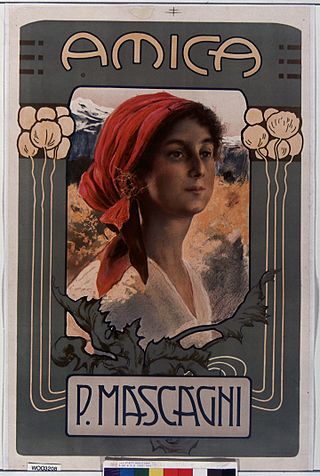
Amica is an opera in two acts by Pietro Mascagni, originally composed to a libretto by Paul Bérel. The only opera by Mascagni with a French libretto, it was an immediate success with both the audience and the critics on its opening night at the Théâtre du Casino in Monte-Carlo on 16 March 1905. Mascagni himself conducted the performance. The opera had its Italian premiere on 13 May 1905 at the Teatro Costanzi in Rome.

L'americano is an intermezzo for four voices in two acts by composer Niccolò Piccinni with an Italian libretto by Angelo Lungi. The opera was premiered on 22 February 1772, at the Teatro Valle in Rome in celebration of Carnival. Musically, this work is unusual as it is much lengthier than most intermezzos and has an abundance of arias but very few ensemble numbers and duets.

Le astuzie femminili is a dramma giocoso in four acts by Domenico Cimarosa with an Italian libretto by Giuseppe Palomba. The opera buffa premiered at the Teatro dei Fiorentini in Naples, Italy, on 26 August 1794. The opera was subsequently performed in Barcelona in 1795, Lisbon in 1797, Vienna in 1799, Paris in 1802, and London in 1804, remaining popular during the first quarter of the nineteenth century. Although not performed often today, the opera is still occasionally revived and a number of recordings have been made.

Il re is a novella or opera in one act and three scenes by composer Umberto Giordano to an Italian libretto by Giovacchino Forzano. The opera premiered at La Scala in Milan on 12 January 1929.

Guido et Ginevra, ou La Peste de Florence is a grand opera in five acts by Fromental Halévy to a libretto by Eugène Scribe. It was premiered on 5 March 1838 by the Paris Opera at the Salle Le Peletier.

Antonio Cagnoni was an Italian composer. Primarily known for his twenty operas, his work is characterized by his use of leitmotifs and moderately dissonant harmonies. In addition to writing music for the stage, he composed a modest amount of sacred music, most notably a Requiem in 1888. He also contributed the third movement, Quid sum miser, to the Messa per Rossini, a collaborative work created by thirteen composers to honor Gioacchino Rossini.

Salvator Rosa is an opera seria in four acts composed by Antônio Carlos Gomes to a libretto in Italian by Antonio Ghislanzoni. It premiered at the Teatro Carlo Felice in Genoa on 21 March 1874. The plot is based on Eugène de Mirecourt's 1851 adventure novel, Masaniello, in turn loosely based on the lives of the Italian painter and poet, Salvator Rosa and Masaniello, a Neapolitan fisherman, who became leader of the 1647 revolt against the Spanish Habsburg rule in Naples.

Tutti in maschera is an opera by Carlo Pedrotti. The libretto is by Marco Marcelliano Marcello, based on the 1759 comedy L'impresario delle Smirne by Carlo Goldoni. It was premiered at the Teatro Nuovo, Verona, on 4 November 1856.
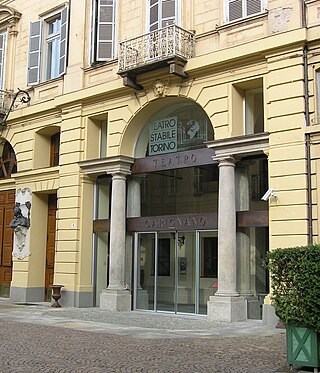
The Teatro Carignano is a theatre in Turin and one of the oldest and most important theatres in Italy. Designed by Benedetto Alfieri, it is located opposite the Palazzo Carignano. Building commenced in 1752 and the theatre was inaugurated the following year with a performance of Baldassare Galuppi's opera, Calamità de' cuori. Much of the theatre was destroyed in a fire in 1786, but it was rebuilt in a few months using Alfieri's original plans. Since then it has undergone several renovations. Although today it is primarily used for performances of plays, in the past it was an important opera house. The theatre is owned by the City of Turin but administered by the theatre company, Teatro Stabile di Torino, and is one of the company's principal performing venues.
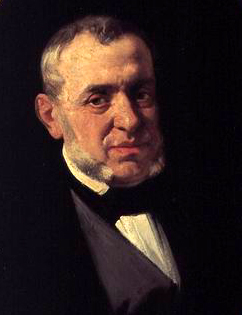
Caritea, regina di Spagna, ossia La morte di Don Alfonso re di Portogallo, is an opera in two acts by Saverio Mercadante, with a libretto by Paolo Pola. It was premiered at Teatro La Fenice in Venice on 21 February 1826.

L'ultimo giorno di Pompei is an opera in two acts composed by Giovanni Pacini to an Italian libretto by Andrea Leone Tottola. It premiered to great success at the Teatro San Carlo in Naples on 19 November 1825 followed by productions in the major opera houses of Italy, Austria, France, and Portugal. When Pacini's popularity declined in the mid-19th century, the opera was all but forgotten until 1996 when it received its first performance in modern times at the Festival della Valle d'Itria in Martina Franca. L'ultimo giorno di Pompei influenced either directly or indirectly several other 19th-century works, most notably Karl Bryullov's 1833 painting, The Last Day of Pompeii.
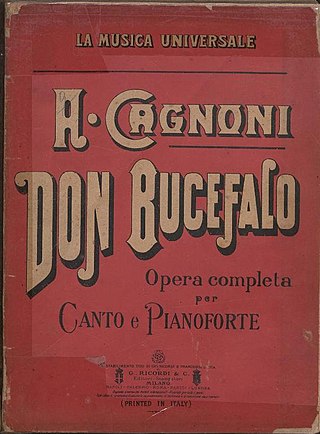
Don Bucefalo is an opera in three acts composed by Antonio Cagnoni to a libretto by Calisto Bassi. Bassi's libretto was based on the libretto by Giuseppe Palomba to Le cantatrici villane (1799) by Valentino Fioravanti. Don Bucefalo premiered on 28 June 1847 at the Milan Conservatory.
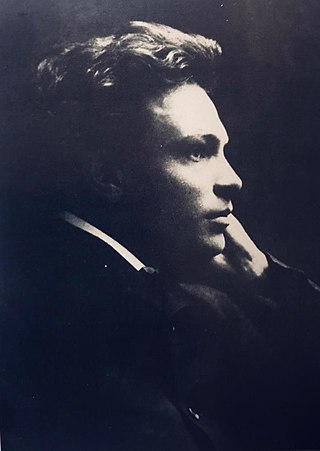
La bella dormente nel bosco is an opera in three acts by Ottorino Respighi to a libretto by Gian Bistolfi based on Charles Perrault's fairy tale "Sleeping Beauty".

Pelagio is an opera in four acts by Saverio Mercadante. The Italian-language libretto was by Marco D'Arienzo. It premiered on 12 February 1857 at the Teatro San Carlo, Naples, to great success.
Notes
Sources